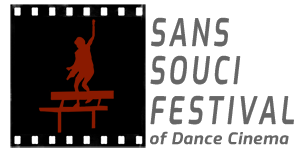Dance cinema? Dance for camera? Dance for THE camera? Dance film? Videodance/Screendance?
What is it? And why does it have so many names?
These are just a few of the terms for an art form that can present a spectrum of theoretical and technical approaches and a variety of experiences for the viewer, but where dance and filmmaking integrate to form the primary vehicle of the work. While Sans Souci also exhibits multimedia performance work, here we’ll try to describe the works that make up the bulk of our screening events. These works could be called screendance, dance film, dance for camera, cinedans, videodance/videodança/vidéo-danse, choreocinema, or other similar terms, or may fall under the umbrellas of experimental film or video art. The International Journal of Screendance and the Oxford Handbook of Screendance Studies have adopted the term screendance, signaling its acceptance in academic publications. However, there are myriad names for this form, reflecting the cultural specificities of the places where it is produced. On the SSF Board, we have members hailing from Mexico, the US, the UK, and Brazil, who use or have used the terms video danza, dance film, screendance, and videodança.
These films are generally artistic shorts, independently made, where dance is the main event.
In order to be a screendance, a work must be:
- defined by choreographic intention in dancing or movement
- defined by camera work, cinematic form, and/or editing techniques
What kinds of dance cinema does Sans Souci screen?
While the bulk of our events are 60-to-90-minute screenings, individually curated for each venue, SSF is also proud to include live multimedia performances and installations from time to time. At our screenings you’ll always discover a variety of films, because we like to include something for everyone. In fact, we use the term “dance cinema” because we feel it is broad enough to encompass all of the forms mentioned above, plus multimedia live performance, dance documentaries, and even new forms we haven’t yet come to know and love.
We’re interested in film and video works that integrate choreography and cinematography. In our dance film category, we’re not interested in documentations or recordings of dance on a stage or in a studio — cinematic elements must be an integral part of the entry. Likewise, we’re not interested in films that are mostly a narrative story with a few dance scenes here or there (think of your favorite film musical), because dance must be vital to the identity of the work.
In the Performance Documentation / Hybrid category, we’re looking for films that feature a creative or unusual method for documenting a live dance/movement performance, or films that began as a dance project for a stage, site-specific location, or other live performance, but were re-crafted into a film. We are interested in unique and creative approaches to documentation, and the use of cinematic elements in transforming the work from live performance into film/video art. Cinematic elements may include multiple or moving perspectives, editing techniques, etc. In this new category, we are NOT looking for a single still camera documentation of a performance.
Depending on whom you ask, music videos may or may not be considered screendance; we do screen music videos when the dancing is truly a central element of the piece. We also screen dance documentaries, as we’re interested in films that craft a new understanding of dance for our audiences. We also have a long history of screening the works of students and emerging artists.
Within these general guidelines, we love it all – choreographed or improvised, virtuosic or pedestrian movement, from the first time filmmaker to the seasoned professional, and from the most to least well known dance styles – we want to build an audience big enough for all kinds of dance cinema.
If you’ve never seen dance cinema before, you’re in for a treat — check out our last few highlight reels.
